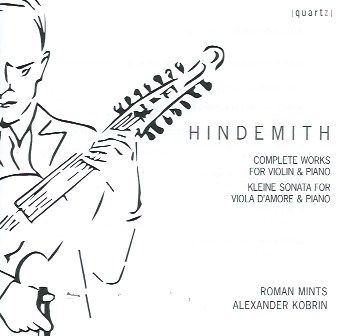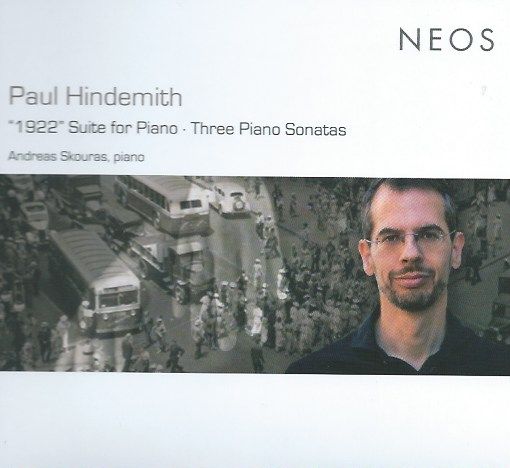A Tale of Two Hindemiths ...
Music for violin and piano, and for piano solo, from this still under-rated composer

... and the promise of a third. Three discs, that is, he's not self-replicating. A later post will focus on Hindemith's wonderful Symphony, Mathis der Maler. But here we have a a relatively recent release of the complete works for violin and piano (plus the Sonata for Viola d'amore and piano) on Quartz, plus a new release of piano music on the Neos label. We're covering a fair amount of ground today (although possibly not as much as we did yesterday with five Mahler Songs of the Earth)!
Let's start with the violin music. Four Sonatas, a "Kleine Sonata" for viola d'amore ( a strange term as there are pieces on the disc called "Sonata" that are shorter) and a couple of smaller pieces (the 1936 Trauermusik and the meditation from the 1938 ballet Nobilissima Visione). The visinonary violinist/violist Roman Mints has always been a bit of a maverick. His Moscow chamber music festival "Homecomings," co-founded with Dmitri Bulgakov, was intended to address the splintering of Russian talent to other countries due to the fragile musical education system in Russia in the 1990s; it concentrated on themed concerts, and alway finding new works to present. Mints' other recordings feature music by Desyatnikov, Schnittke and Elena Langer, among others.
For this disc of Hindemith chamber works, the idea was to redress a misunderstanding. As Mints himself put it to me once, "I think that the attitude to Hindemith is that 'we give it to him that he is like a major composer or whatever but we don’t really like him, we know who he is, but he is boring or wheatever'. But he is not. Firstly, people who think that way associate Hindemith with his late style, but he is more than just that. Also, people just don’t know enough, maybe they've heard a few sonatas for various instruments , they don't know how versatile this composer is".
Versatile he certainly is. Here's that 1922 Viola d'amore sonata. The pianist on the Quartz disc, and here in this video, is the excellent Alexander Kobrin, a musician of the highest integrity and sensitivity whose recordings have never once disappointed (his Schubert D960 on Centaur is incredible). In this Hindemith, the intensity and beauty of the Sehr Langsam (very slow) section, from 1"52, is stunning, as is the variety of string colour Mints brings throughout:
(Mints told me this sonata can only be played on a viola d'amore; in the sense that it's not like the Schubert "Arpeggione" Sonata that can be played on viola or cello.)
It's Hindemith's harmonic language that is so telling, it's so poignant the way it so often sits between major and minor. The first movement of the Sonata in E (1935) tells its own poignant story:
This disc is absolutely a meeting of equals between Mints and Kobrin. Mints told me that he wants to bury preconceptions about Hindemith and convert people to that composer's cause. He converted me, anyway.
And so to some Hindemith piano music courtesy of pianist (and harpsichordist, elsewhere) Andreas Skouras:

I say harpsichord because, also on the Neos label, Skouras plays Wolfgang Jacobi's Harpsichord Concerto. Here we are all piano, and what a recording it is. Just as Mints is almost guaranteed to covert unbelievers to the Hindemith string output, so Skouros should bring many to the solo piano side.
One aspect of Hindemith we meet in the so-called "1922" Suite for Piano is the use of popular music, something that was more under wraps on the string disc. Here's the catchy "Ragtime," which remains undeniably Hindemith through and through:
There is a lot of competition for the piano music on disc: amazingly perhaps, Sviatoslav Richter pops up in the First Sonata (Richter Live in Kiev, if you can find it on the little-known TNC label); both Glenn Gould and Earl Wild can be found in No. 3. If it's intriguing couplings you're after, there's a twofer on Lyrita on which Sheila Randell performs Hindemith's Sonatas Nos. 2 and 3 and the Op. 19 Dance Pieces, coupling them with music by Edward MacDowell (Sonatas Nos. 1 and 4), and to my ears it works beautifully!
All three Sonatas were written in 1936. The First is a hefty piece of nearly 27 minutes in Skouras' performance. At its heart (literally: the third of five movements) is a movement that Skouras plays with the utmost knowing, a nine-minute feast of all good things Hindemithian, from the teasingly sprightly to the luminous. The recording of the piano itself is fabulous, too:
The amazing thing about the internet is that, while physical copies of the Richter performance of No. 1 might be hard to locate (and probably expensive), we need simply click a mouse a couple of times:
The Second Sonata is the most approachable by some way; it is also, by some way, the shortest. Try the first movement; Skouras' touch is simply lovely:
The Third Sonata, meanwhile, is in many ways the most elusive and challenging: a funeral march and various occurances of fugue, including the whole of the final movement. That's not to say there's no fun though: listen to the skittish second movement:
I see Skouras' disc was crowdfunded via startnext.com; we should be incredibly grateful it made the light of day. The two discs combined offer the perfect introduction to the music of Hindemith; and they complement each other so well. I note that at the time of writing the Mints is available at a most attractive price at the Amazon link below, too!
